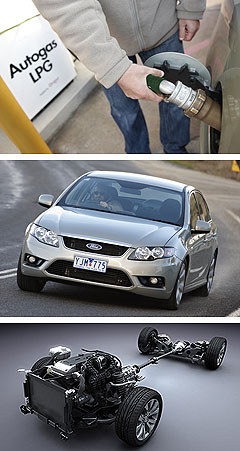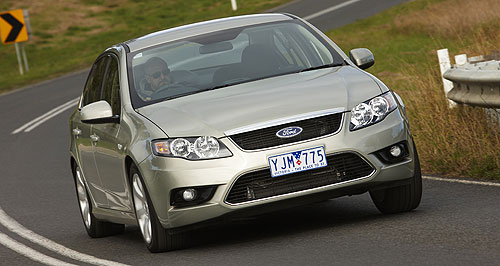Make / Model Search
News - Ford - FalconEcoLPi could extend inline-six lifespanLease on life: Ford’s EcoLPi engine is designed to extend beyond the current Euro 4 emissions standard, and to be compatible with new technology such as direct fuel injection. Ford’s new LPG system looks set to run in Aussie-built I6 beyond mid-decade26 Jul 2011 FORD has given its strongest indication yet that the lifespan of its venerable Australian-built inline-six engine will extend beyond 2016 and meet the forthcoming Euro 5 emissions standard, following the development of the EcoLPi system just launched in the FG Falcon. Speaking to GoAuto at the EcoLPi launch in Melbourne last week, Ford Australia powertrain engineering manager Pritika Maharaj said the new LPG system was designed to be in service “beyond Euro 4” – the current standard, which brought an end to the previous E-Gas system last year – as circumstances dictate. While she would not comment on the life expectancy of the Geelong-made I6 in future Falcon and Territory models, Ms Maharaj said there was little point in Ford Australia investing heavily in the Euro 4-compliant EcoLPi system if it was to be replaced before long. Ford Australia also confirmed last week that the EcoLPi system was compatible with higher-tech engines, including direct-injection units like the EcoBoost V6, which could replace the I6 later this decade and bring an end to local Ford engine production. “You have to ask why Ford would bother developing the LPi engine that was ‘beyond Euro 4’ if it wasn’t going to have a future,” Ms Maharaj said. The federal government announced last month that from November 1, 2016, all new vehicles in Australia must comply with Euro 5 emissions requirements, while stricter Euro 6 regulations come in for all new cars sold from July 1, 2018.  Left: Ford Falcon EcoLPi. Below: Falcon I6 powertrain. Left: Ford Falcon EcoLPi. Below: Falcon I6 powertrain.‘Core Euro 5’ measures will also be introduced from November 1, 2013, although these will apply to cars, SUVs and light trucks new to the market from that date. Ford Australia public affairs director Sinead McAlary told GoAuto in June that, while the I6 in all its iterations can be engineered for Euro 5, “significant time and resources would be required to do so”. “One of the advantages of the regulatory timing we have received is that we actually have the time now to work through all the options to determine if that is the right course of action to take,” she said. Integral to Ford’s planning will be the switch to a new-generation Falcon around the same time as ‘full Euro 5’ takes effect in 2016. The ‘E8’ platform underpinning the current Falcon and Territory reaches the end of its life in 2016, with Australia adopting a new-generation global large-car platform under the ‘One Ford’ philosophy. To form the basis of Ford’s future Mondeo, Taurus and various mid-sized SUV replacements for the Territory and (eventually) US-market Explorer, the new platform is expected to use transverse-mounted engines such as a derivative of the 3.5-litre direct-injection EcoBoost V6, and drive either the front or all four wheels depending on the application. Not coincidentally, the FG Falcon’s EcoLPi system is not only unique in the world, it has been engineered to be adapted to other engine sizes and configurations. According to Ford Australia’s base engine and alternative fuel supervisor, Simon Flint, while there is nothing in the pipeline from his point of view, EcoLPi can be applied to any future engine development, including the direct-injection units like the EcoBoost V6. “Direct injection is the future,” he said. “And LPi liquid injection has the most future potential. The ability to apply the EcoLPi technology to essentially any high-level multi-point port gasoline engine is there. There is no real technical reason why you couldn’t do that. “The biggest challenge is the different markets around the globe. Ford is now very much more a global engineering company – we’re not so much Ford Australia as Ford Asia Pacific – so on that perspective clearly the Australian engineering team is very proud of our achievement and believe the technology can go many ways. “There’s no technological reason why you cannot combine LPi with direct-injection engines. Of course, that’s still in its infancy as far as that technology moving towards the customer is concerned. “There are real engineering benefits in combining direct injection and LPi, too. It’s a big area of research at the moment, and that’s probably the next evolution.” It is now known that Ford Australia originally set out to engineer an LPi system for the proposed Duratec V6 engine that was previously to be imported for the FG Falcon and the petrol-powered Territory from 2010 until a decision was made to stick with the Geelong-built I6. Some of the $232 million that Ford Australia has invested in the latest Falcon and derivatives – with the help of $42 million in federal government green-car funding – has been used to develop the EcoLPi system, along with the TDCi V6 diesel introduced in the SZ Territory earlier this year and the four-cylinder turbocharged EcoBoost engine due to be released in the facelifted Falcon in the first quarter of 2012.  Read more22nd of July 2011  Pent-up demand to drive EcoLPi salesFord is counting on a waiting buyer base for the Falcon's new EcoLPi system19th of July 2011  First drive: Ford opens Falcon EcoLPi doorsFord’s make-or-break year rolls on with the crucial new Falcon EcoLPi range14th of June 2011  Ford buys time on engine deadlinePhased Euro 5 emissions introduction points to 2016 crunch date for Ford I6 |
Click to shareFord articlesMotor industry news |











Facebook Twitter Instagram